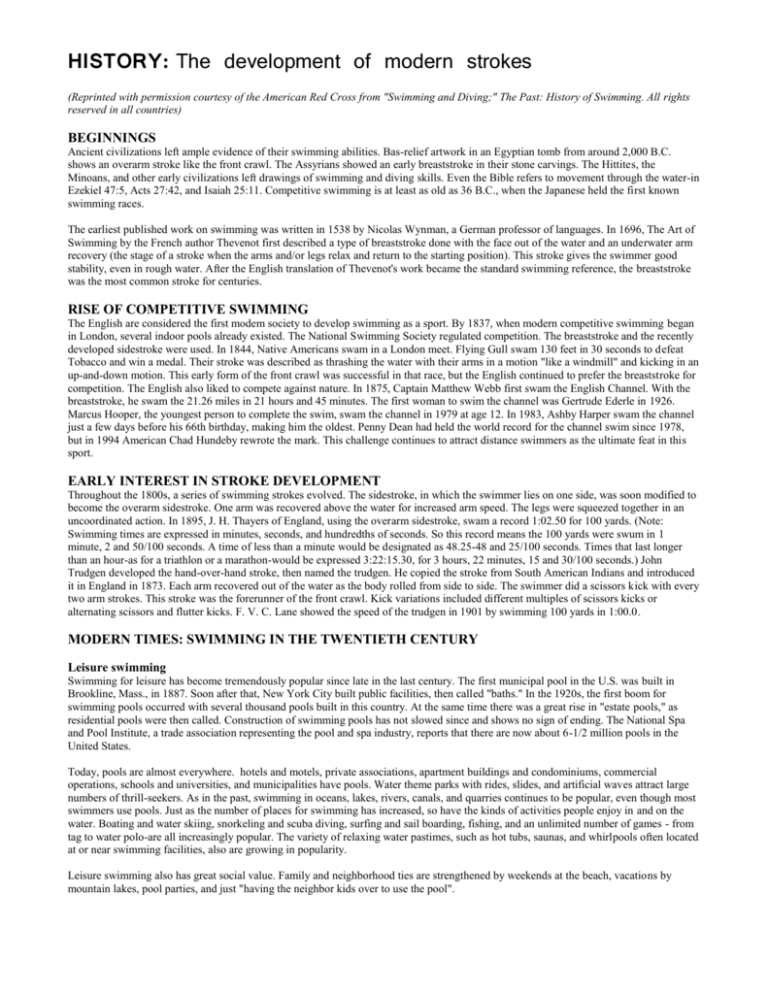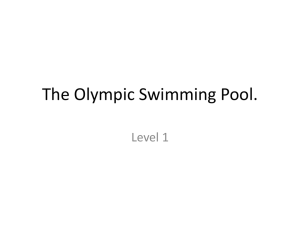
HISTORY: The development of modern strokes
(Reprinted with permission courtesy of the American Red Cross from "Swimming and Diving;" The Past: History of Swimming. All rights
reserved in all countries)
BEGINNINGS
Ancient civilizations left ample evidence of their swimming abilities. Bas-relief artwork in an Egyptian tomb from around 2,000 B.C.
shows an overarm stroke like the front crawl. The Assyrians showed an early breaststroke in their stone carvings. The Hittites, the
Minoans, and other early civilizations left drawings of swimming and diving skills. Even the Bible refers to movement through the water-in
Ezekiel 47:5, Acts 27:42, and Isaiah 25:11. Competitive swimming is at least as old as 36 B.C., when the Japanese held the first known
swimming races.
The earliest published work on swimming was written in 1538 by Nicolas Wynman, a German professor of languages. In 1696, The Art of
Swimming by the French author Thevenot first described a type of breaststroke done with the face out of the water and an underwater arm
recovery (the stage of a stroke when the arms and/or legs relax and return to the starting position). This stroke gives the swimmer good
stability, even in rough water. After the English translation of Thevenot's work became the standard swimming reference, the breaststroke
was the most common stroke for centuries.
RISE OF COMPETITIVE SWIMMING
The English are considered the first modem society to develop swimming as a sport. By 1837, when modern competitive swimming began
in London, several indoor pools already existed. The National Swimming Society regulated competition. The breaststroke and the recently
developed sidestroke were used. In 1844, Native Americans swam in a London meet. Flying Gull swam 130 feet in 30 seconds to defeat
Tobacco and win a medal. Their stroke was described as thrashing the water with their arms in a motion "like a windmill" and kicking in an
up-and-down motion. This early form of the front crawl was successful in that race, but the English continued to prefer the breaststroke for
competition. The English also liked to compete against nature. In 1875, Captain Matthew Webb first swam the English Channel. With the
breaststroke, he swam the 21.26 miles in 21 hours and 45 minutes. The first woman to swim the channel was Gertrude Ederle in 1926.
Marcus Hooper, the youngest person to complete the swim, swam the channel in 1979 at age 12. In 1983, Ashby Harper swam the channel
just a few days before his 66th birthday, making him the oldest. Penny Dean had held the world record for the channel swim since 1978,
but in 1994 American Chad Hundeby rewrote the mark. This challenge continues to attract distance swimmers as the ultimate feat in this
sport.
EARLY INTEREST IN STROKE DEVELOPMENT
Throughout the 1800s, a series of swimming strokes evolved. The sidestroke, in which the swimmer lies on one side, was soon modified to
become the overarm sidestroke. One arm was recovered above the water for increased arm speed. The legs were squeezed together in an
uncoordinated action. In 1895, J. H. Thayers of England, using the overarm sidestroke, swam a record 1:02.50 for 100 yards. (Note:
Swimming times are expressed in minutes, seconds, and hundredths of seconds. So this record means the 100 yards were swum in 1
minute, 2 and 50/100 seconds. A time of less than a minute would be designated as 48.25-48 and 25/100 seconds. Times that last longer
than an hour-as for a triathlon or a marathon-would be expressed 3:22:15.30, for 3 hours, 22 minutes, 15 and 30/100 seconds.) John
Trudgen developed the hand-over-hand stroke, then named the trudgen. He copied the stroke from South American Indians and introduced
it in England in 1873. Each arm recovered out of the water as the body rolled from side to side. The swimmer did a scissors kick with every
two arm strokes. This stroke was the forerunner of the front crawl. Kick variations included different multiples of scissors kicks or
alternating scissors and flutter kicks. F. V. C. Lane showed the speed of the trudgen in 1901 by swimming 100 yards in 1:00.0.
MODERN TIMES: SWIMMING IN THE TWENTIETH CENTURY
Leisure swimming
Swimming for leisure has become tremendously popular since late in the last century. The first municipal pool in the U.S. was built in
Brookline, Mass., in 1887. Soon after that, New York City built public facilities, then called "baths." In the 1920s, the first boom for
swimming pools occurred with several thousand pools built in this country. At the same time there was a great rise in "estate pools," as
residential pools were then called. Construction of swimming pools has not slowed since and shows no sign of ending. The National Spa
and Pool Institute, a trade association representing the pool and spa industry, reports that there are now about 6-1/2 million pools in the
United States.
Today, pools are almost everywhere. hotels and motels, private associations, apartment buildings and condominiums, commercial
operations, schools and universities, and municipalities have pools. Water theme parks with rides, slides, and artificial waves attract large
numbers of thrill-seekers. As in the past, swimming in oceans, lakes, rivers, canals, and quarries continues to be popular, even though most
swimmers use pools. Just as the number of places for swimming has increased, so have the kinds of activities people enjoy in and on the
water. Boating and water skiing, snorkeling and scuba diving, surfing and sail boarding, fishing, and an unlimited number of games - from
tag to water polo-are all increasingly popular. The variety of relaxing water pastimes, such as hot tubs, saunas, and whirlpools often located
at or near swimming facilities, also are growing in popularity.
Leisure swimming also has great social value. Family and neighborhood ties are strengthened by weekends at the beach, vacations by
mountain lakes, pool parties, and just "having the neighbor kids over to use the pool".
HISTORY: The development of modern strokes
Fitness aerobics
The restorative power of water has long been recognized Ancient cultures such as Greece and Rome had their "baths." The Romans wrote
that "health comes from water" on the walls of their public facilities.
In our own time, the importance of aerobic exercise and the advantages of
exercising in water are well known. Water exercise leads to less stress and fewer injuries to tendons and joints. From 1961, the Red Cross
Swim and Stay Fit program has encouraged fitness by keeping track of one's swimming distance. Research on conditioning and aerobics in
the 1960s revolutionized the world of water and most other sports. The emphasis changed to cardiovascular conditioning rather than simply
developing muscles. Physical fitness now focuses on heart rate, progressive resistance, overload, metabolism, and other aspects of fitness.
HISTORY: The development of modern strokes
THE DEVELOPMENT OF MODERN STROKES
Although people have swum since ancient times, swimming strokes have been greatly refined in the past 100 years. Competitive
swimming, most notably the modern Olympic Games, begun in Athens, Greece, in 1896 increased interest in strokes. Scientific stroke
analysis has helped produce more varied strokes, greater speeds, and a better understanding of propulsion through the water.
Front Crawl
The inefficiency of the trudgen kick led Australian Richard Cavill to try new methods. He used a stroke he observed natives of the
Solomon Islands using, which combined an up-and-down kick with an alternating overarm stroke. He used the new stroke in 1902 at the
International Championships and set a new world record (100 yards in 58.4 seconds). This stroke became known as the Australian crawl.
Breaststroke and Butterfly
Swimming research has helped the breaststroke evolve. Other strokes are
faster, but the breaststroke is still a competitive event. Until the l950s, the breaststroke was the only stroke with a required style. The
underwater recovery of both arms and legs in the breaststroke is a natural barrier to speed.
In 1934, however, David Armbruster, coach at the University of Iowa, devised a double overarm recovery out of the water. This "butterfly"
arm action gave more speed but required greater training and conditioning. Then in 1935, Jack Sieg, a University of Iowa swimmer,
developed the skill of swimming on his side and beating his legs in unison like a fish's tail. He then developed the leg action face down.
Armbruster and Sieg combined the butterfly arm action with this leg action and learned to coordinate the two efficiently. With two kicks to
each butterfly arm action, Sieg swam 100 yards in 1:00.2. This kick was named the dolphin fishtail kick.
Even though the butterfly breaststroke, as it was called, was faster than the breaststroke, the dolphin fishtail kick was declared a violation
of competitive rules. For the next 20 years, champion breaststrokers used an out-of-water arm recovery (butterfly) with a shortened
breaststroke kick. In 1953, the butterfly stroke with the dolphin kick was legalized as a separate stroke for competition. Many swimmers
say the "wiggle" is the key to the stroke and that a swimmer who can undulate through the water naturally can more easily learn the
butterfly.
Backstroke
Since its first appearance at the 1900 Olympic Games, the backstroke has changed little. It is the only swimming stroke that starts with a
push off the wall of the pool instead of a dive. Its leg action is essentially an upside-down variation of the crawl's flutter kick, with the arms
reaching up and out of the water. Adolph Kiefer, who dominated backstroke swimming from 1935 to 1945, got his thrust by pulling with
his arms held straight in the water. But recently Australian backstrokers discovered that they could get more horizontal thrust by slightly
bending the arm as it came around underwater, and other swimmers have generally adopted their style.
As the stroke evolved further, backstrokers realized that they could go faster doing a streamlined dolphin kick underwater, similar to that of
the butterfly. World records were shattered with this method until 1989 when FINA, swimming's governing body, limited underwater
dolphin kicking on the backstroke to 15 meters.
COMPETITIVE SWIMMING
As swimmers refine strokes or make changes, the best way to see if the new
stroke is an improvement is to use it in competition. This is why so much attention is paid to speed and endurance records.
Swimmers Setting Records
Alfred Hajos of Hungary won the first Olympic men's swimming gold medal in the Olympic Games in Athens in 1896. He had a time of
1:22.20 for the 100-meter freestyle, a competitive event in which any stroke is allowed. Since then, new swimming records have been set
regularly.
While names have come and gone from the record books, several U.S. swimmers have left their mark on the swimming world. Johnny
Weissmuller won 5 Olympic medals and 36 national championships and never lost a race in his 10-year career. His record of 51 seconds
for the 100-yard freestyle stood for over 17 years. Tracy Caulkins set world records in the 200-meter butterfly and the 400-meter individual
medley (an event in which the competitor swims one quarter of the total distance using a different competitive stroke in a prescribed order:
butterfly, backstroke, breaststroke, freestyle). She broke her own world record in the 200-meter individual medley three times. Besides
winning three Olympic medals, she is the only swimmer ever to hold all of the U.S. records at the same time. Mark Spitz won seven gold
medals in the 1972 Olympics in Munich, more than any other swimmer in the history of Olympic competition.
The first modern Olympic Games had only four swimming events, three of them freestyle. The second Olympics in Paris in 1900 included
three unusual swimming events. One used an obstacle course; another was a test of underwater swimming endurance; the third was a
4,000-meter event, the longest competitive swimming event ever. None of the three was ever used in the Olympics again.
For a variety of reasons, women were excluded from swimming in the first several Olympic Games. In 1896 and again in 1906, women
could not participate because the developer of the modern games, Pierre de Coubertin, held firmly to the assumption, common in the
HISTORY: The development of modern strokes
Victorian era, that women were too frail to engage in competitive sports. In 1900, the committee organizing the Paris games allowed
women to participate in golf and tennis, since these were popular sports in Europe. (Until the International Olympic Committee was
formed, events at Olympic Games were chosen by the host committee.)
The 1904 games in St. Louis were dominated by the President of the Amateur Athletic Union (AAU), James E. Sullivan, who allowed
women to participate only in archery, a demonstration sport. Sullivan's control not only of the Olympics but of the AAU is attested by the
fact that one month after his death in 1914, women's events were allowed by the AAU. In 1908, women were allowed to compete in
archery, and women's gymnastics was a demonstration event.
Women's swimming made its debut in the 1912 Games at the prompting of the group that later became the International Olympic
Committee. As early as 1914 in this country, the Women's Swimming Association of New York, another outgrowth of the U.S. Volunteer
Life Saving Corps, provided the first opportunity for women to train for national and international competition.
From the humble beginning with four swimming events, the Olympics have developed to 32 swimming races, 16 for men and 16 for
women.
HISTORY: The development of modern strokes
Open Water Swimming
Swimming in lakes, rivers and the sea was the first swimming ever attempted. Historians show references to swimming these bodies of
water by ancient Middle Eastern and Greek civilizations. Ironically, open water swimming remains the only form of competitive swimming
not yet contested in the Olympic Games.
Many people view open water racing as an extreme sport. Participants jostle for position at the beginning of each race. As the gun sounds,
elbows fly and slower swimmers can be lost in the splash. It is not uncommon to see jostling to gain the inside track around large orange
floats that define the course. Swimmers who do not pay attention may stray outside the course and swim costly extra distance. All these
factors lead to a very unpredictable and aggressive race that is exciting to watch.
Open water swimming has evolved into a competitive event that is seeking Olympic status. Competitions are regularly held at 5, 10 and 25
kilometers. A World Championship, sanctioned by FINA, is currently the discipline's biggest event.
COMPETITION FOR PEOPLE WITH DISABILITIES
Swimming competition for people with disabilities also has a long history.
In 1924, the Comite International des Sports des Sourds (CISS-the International Committee for Sports for the Deaf) held the first Summer
World Games for men and women who were deaf. Athletes with cognitive disabilities first joined in international swimming competition in
1968, with the International Summer Special Olympics. The most recent Special Olympics had 22 events for men and 22 for women. Other
organizations also provide aquatic competitions for people with disabilities. In 1998, USA Swimming became the first National Governing
Body in the Olympic Movement to conduct a championship meet for all categories of disabled athletes.
RESEARCH AND TRAINING TECHNIQUES
Unlike walking and other motions, swimming is not a natural activity for
the human body. A standing position on land does not translate easily to a horizontal swimming position. Therefore, people throughout
history have experimented with different ways to swim better. Our ability to use a variety of swimming techniques is due to the ball and
socket joints of our shoulders and hips.
HISTORY: The development of modern strokes
Early swimmers experimented by trial and error and watched others. In 1928, however, David Armbruster first filmed swimmers under
water to study strokes. The Japanese also photographed and studied world-class athletes, using their research to produce a swim team that
dominated the 1932 Olympic Games. This marked the beginning of research into stroke mechanics.
At the same time, others advanced the role of conditioning. The 1956 Olympic Games in Melbourne, Australia, showed the clear value of
conditioning. The host team for those games had fantastic success, which was due to their training program, not their stroke technique.
American swimming coaches began adopting training methods like those used by track coaches to help runners break the 4-minute mile.
Current research focuses on the forces that act on a body moving through the water, the science of hydrodynamics. Dr. James Counsilman,
Charles Silvia, and Dr. Ernest Maglischo have revolutionized stroke mechanics with their pioneering and painstaking work. This increased
understanding of stroke mechanics has helped researchers and coaches improve swimmers' times in competition. American swim
researchers include C. H. McCloy and Robert Kiphuth, who was awarded the Medal of Freedom, the United States' highest civilian award,
by President Johnson in 1963. They and others have given swimmers new techniques, drills, and training methods based on these scientific
principles.
HISTORY: The development of modern strokes






